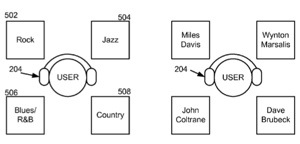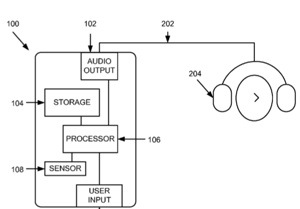An Apple patent (number 20110153044) for a directional audio interface for a portable media device has appeared at the US Patent & Trademark Office. It involves controlling iOS devices through an audio interface.
Methods and apparatus for a user to interact with and control a portable media device through an audio user interface are discolsed. The audio user interface includes one or more audible control nodes perceived by the user to be spatially located at different points about the user of the portable media device.
A sensor in the portable media device senses a movement of the portable media device by the user toward one or more of the audible control nodes. The operation of the portable device is modified in accordance with the sensed movement of the portable media device. Aram Lindahl and Richard Powell are the inventors.
Here's Apple's background and summary of the invention: "The increased density and lower cost per Mbyte of storage media, initially with hard disk storage and continuing with flash memory, has resulted in a multitude of portable media devices capable of conveniently storing and enabling retrieval of audio, image, video and multimedia (e.g. game) files.
"With their small size and portability, portable media devices can be used during a variety of activities, for example while reading, walking, running, biking and driving. While engaged in these activities, the user can be 'visually' focused on the activity and simultaneously 'aurally' connected with the portable media device. Interacting with the device without using a visual interface can be accomplished with limited functionality on today's devices, such as by depressing a simple on/off button and operating a volume control on a headset connected by a wire or wirelessly to the device.
"More complex interactions with the device, such as searching for and selecting a particular stored media file can require the user to disengage visually from the current activity to use a displayed graphical user interface on the device. The graphical user interface can include control inputs, e.g. a touch screen, touch pad or a scroll wheel button by which the user can navigate through the stored media libraries on the device.
"Using the graphical user interface, however, can disrupt the activity in which the user is otherwise visually engaged, and some portable media devices do not include a visual display. Thus there exists a need for an alternative user interface that enables the user to interact with and control the portable media device to navigate through and retrieve from a set of media stored in the device.
"This paper describes various embodiments that relate to systems, methods and apparatus that enable a user to interact with a portable media device through an audio user interface. In described embodiments, the audio user interface can include one or more audible control nodes perceived to be spatially located at different points about the user of the portable media device.
"A sensor in the portable media device can sense a movement of the portable media device by the user toward one or more of the audible control nodes. The operation of the portable device can be modified in accordance with the sensed movement of the portable media device.
"In one embodiment, a method for controlling a portable device by a user is disclosed. In the described embodiment, the portable device includes at least a processor and a sensor. The method can be carried out by performing at least the following operations. Receiving a directional audio signal by the user, the directional audio signal being generated by the portable device. In response to receiving the directional audio signal, the user moves the portable device, the movement being sensed by the sensor. An operation of the portable media device is then modified based upon the sensed movement.
"In another embodiment, a portable device arranged to provide an audio user interface to a user of the portable device is disclosed. The portable device includes at least a processor configured to generate a directional audio signal, an audio output circuit configured to communicate the directional audio signal to the user of the portable device, and a sensor configured to sense a movement of the portable device generated by the user in response to the directional audio signal. In the described embodiment, an operation of the portable device is modified in accordance with the sensed movement.
"In still another embodiment, an audio user interface suitable for assisting a user in controlling an electronic device is described. The audio user interface being perceived by the user to include one or more audible control nodes each spatially located at different points about the user. In the described embodiment, the portable device is controlled by the user moving the portable device in the perceived direction of a selected one of the audible control nodes.
"In yet another embodiment, a method of providing to a user an audio user interface in a portable device is described. The method includes at least the following steps. A processor in the portable device generates a directional audio signal having a direction cue and communicates the directional audio signal to the user of the portable device through an audio output circuit. A sensor in the portable device senses a movement of the portable device effected by the user in response to receiving the communicated directional audio signal.
"The processor associates the sensed movement of the portable device with a specific operational change of the portable device. In some embodiments of the method, the sensor in the portable device is arranged to detect at least a change in position, an orientation change and an acceleration of the portable device.
"A method for updating an audio user interface of a portable device that has a processor and a directional audio interface is described. The method can be carried out by performing at least the following operations. Transmitting a directional audio menu including at least one menu item selection to a user of the portable device, sensing a movement of the portable device in response to the transmitted directional audio menu, identifying a menu item selection of the directional audio menu based on the sensed movement, and associating the identified menu item selection in the directional audio menu with the sensed movement."
-- Dennis Sellers















